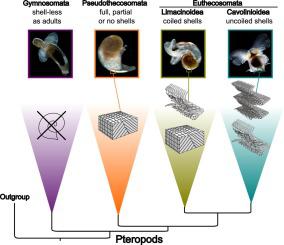Journal of Structural Biology ( IF 3.0 ) Pub Date : 2021-08-30 , DOI: 10.1016/j.jsb.2021.107779 Paula Ramos-Silva 1 , Deborah Wall-Palmer 1 , Ferdinand Marlétaz 2 , Frédéric Marin 3 , Katja T C A Peijnenburg 4

|
Shelled pteropods, known as sea butterflies, are a group of small gastropods that spend their entire lives swimming and drifting in the open ocean. They build thin shells of aragonite, a metastable polymorph of calcium carbonate. Pteropod shells have been shown to experience dissolution and reduced thickness with a decrease in pH and therefore represent valuable bioindicators to monitor the impacts of ocean acidification. Over the past decades, several studies have highlighted the striking diversity of shell microstructures in pteropods, with exceptional mechanical properties, but their evolution and future in acidified waters remains uncertain. Here, we revisit the body-of-work on pteropod biomineralization, focusing on shell microstructures and their evolution. The evolutionary history of pteropods was recently resolved, and thus it is timely to examine their shell microstructures in such context. We analyse new images of shells from fossils and recent species providing a comprehensive overview of their structural diversity. Pteropod shells are made of the crossed lamellar and prismatic microstructures common in molluscs, but also of curved nanofibers which are proposed to form a helical three-dimensional structure. Our analyses suggest that the curved fibres emerged before the split between coiled and uncoiled pteropods and that they form incomplete to multiple helical turns. The curved fibres are seen as an important trait in the adaptation to a planktonic lifestyle, giving maximum strength and flexibility to the pteropod thin and lightweight shells. Finally, we also elucidate on the candidate biomineralization genes underpinning the shell diversity in these important indicators of ocean health.
中文翻译:

翼足类贝壳的进化和生物矿化
带壳的翼足类动物,被称为海蝴蝶,是一群小型腹足类动物,它们一生都在开阔的海洋中游泳和漂流。他们构建了文石的薄壳,这是一种碳酸钙的亚稳态多晶型物。已证明翼足类贝壳会随着 pH 值的降低而溶解并减少厚度,因此是监测海洋酸化影响的有价值的生物指标。在过去的几十年中,几项研究强调了翼足类动物壳微观结构的惊人多样性,具有出色的机械性能,但它们在酸化水中的演变和未来仍不确定。在这里,我们重新审视了翼足类生物矿化的工作主体,重点关注壳微结构及其演化。最近解决了翼足类动物的进化史,因此,在这种情况下检查它们的壳微观结构是及时的。我们分析了来自化石和最近物种的贝壳的新图像,全面概述了它们的结构多样性。翼足类外壳由软体动物中常见的交叉层状和棱柱形微结构制成,但也由弯曲的纳米纤维制成,这些纤维被提议形成螺旋三维结构。我们的分析表明,弯曲的纤维在盘绕和展开的翼足类动物之间分裂之前出现,并且它们形成不完整的多个螺旋圈。弯曲的纤维被视为适应浮游生活方式的重要特征,为翼足类轻薄的外壳提供最大的强度和灵活性。最后,











































 京公网安备 11010802027423号
京公网安备 11010802027423号